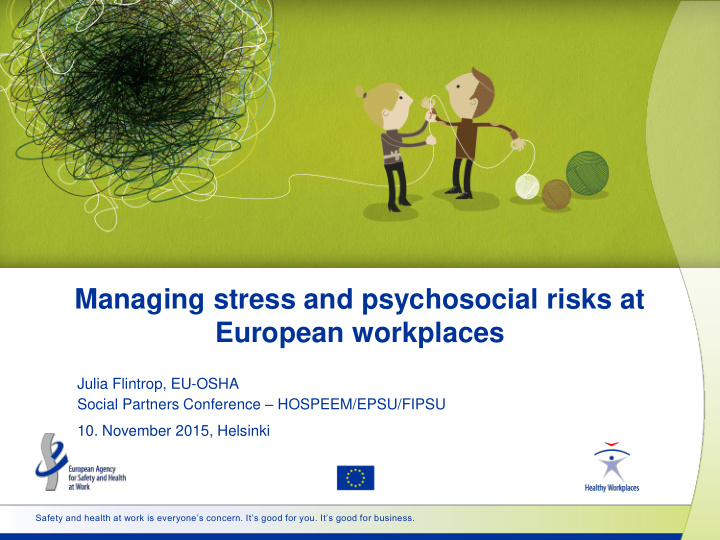



Managing stress and psychosocial risks at European workplaces Julia Flintrop, EU-OSHA Social Partners Conference – HOSPEEM/EPSU/FIPSU 10. November 2015, Helsinki Safety and health at work is everyone’s concern. It’s good for you. It’s good for business.
1. EU-OSHA • Established in 1996 in Bilbao , Spain • To help improve working conditions in the European Union by providing technical, scientific and economic information to people involved in safety and health at work . • An autonomous legal entity set up by the legislator (European Parliament/Council) • Tripartite Board bringing together: - governments, employers’ and workers’ organisations - the European Commission www.healthy-workplaces.eu 2
1. EU-OSHA - our network Croatia www.healthy-workplaces.eu 3
1. EU-OSHA – multi annual programme Anticipating change OSH tools • Foresight methodology • OIRA • E-Tools • Green jobs Raising awareness • Research priorities • Campaigning Facts and figures • NAPO • Micro and small enterprises Networking knowledge • Older workers • OSHWiki • Enterprise Survey on New and Networking & Emerging Risks corporate • Workrelated Diseases communications • Benefits of OSH • International networking www.healthy-workplaces.eu 4
Healthy Workplaces Manage Stress - key objectives Raising awareness about the growing problem with stress and psychosocial risks (increase of mental health problems in general, crisis, growing service sector, general ‘acceleration’ of the world…) Focus on the positive effects of successful psychosocial risk management (better health, better productivity, the business case…) Increasing the enterprises’ practical knowledge on recognising and preventing psychosocial risks at work (providing and promoting the use of simple, practical tools and guidance) www.healthy-workplaces.eu 5
A practical approach: 5 steps Step 1. Step. 2 Identify the Evaluate and hazards prioritise the and those at risks risk Step. 5. Step 3. Monitor and Decide on review the preventive situation actions Step 4. Take action! www.healthy-workplaces.eu 6
The hierarchy of prevention 1. Avoid & eliminate risks 2. Reduce and minimise hazards AND separate from the workers by technical measures by organisational measures by personal measures 3. Individual measures, e.g. modifying behaviour www.healthy-workplaces.eu 7
ESENER survey: Enough information for assessing psychosocial risks Water supply & waste management Human health and social work activities Education Public administration EU-28 Manufacturing Construction Information and communication Real estate activities 0 10 20 30 40 50 60 70 80 90 100 Yes No NA www.healthy-workplaces.eu 8
ESENER survey: Reasons for not assessing psychosocial risks Water supply & waste management Manufacturing Construction Human health and social work activities EU-28 Education Public administration 0 20 40 60 80 100 Risks are already known No major problems Necessary expertise is lacking Procedure is too burdensome www.healthy-workplaces.eu 9
ESENER survey: Management of psychosocial risks Concern about work-related stress, as reported by managers 21% concerned not concerned 79% ESENER survey 2009 & 2014, EU-OSHA www.healthy-workplaces.eu 10
ESENER survey: Procedures in place to deal with… Human health and social work activities Education EU-28 Public administration Construction Agriculture, forestry and fishing Manufacturing 0 10 20 30 40 50 60 70 80 90 100 Violence Bullying or harassment Stress www.healthy-workplaces.eu 11
ESENER survey: Difficulties in addressing psychosocial risks Mining and quarrying Public administration Education Human health and social work activities EU-28 Construction Wholesale and retail trade Agriculture, forestry and fishing 0 10 20 30 40 50 60 Reluctance to talk openly about these issues A lack of awareness among staff A lack of expertise or specialist support A lack of awareness among management www.healthy-workplaces.eu 12
ESENER survey: Management of psychosocial risks Drivers Good general OSH management and reported concern for work- related stress The main drivers reported by managers: - Requests from employees - Desire to reduce absenteeism - Legal obligations www.healthy-workplaces.eu 13
ESENER survey: Management of psychosocial risks Barriers Lack of technical support and guidance and lack of expertise Lack of resources - higher number of measures in place than those not reporting this barrier Sensitivity of the issue - more measures in place than those not reporting this barrier Conclusion: Reported barriers very much depend on the different stages of the companies implementing psychosocial risk management www.healthy-workplaces.eu 14
ESENER survey: Management of psychosocial risks Worker participation Workplaces that have formal worker representation are more likely: - to report management commitment to safety and health - to have preventive measures in place for both general OSH and psychosocial risks - to involve employees (consultation and participation) in the process of OSH and psychosocial risk management Workplaces that have formal worker representation and a high level of management commitment to OSH are more likely to report that their organisation’s OSH and psychosocial risk management are effective www.healthy-workplaces.eu 15
ESENER survey: Management of psychosocial risks Employee participation in setting up psychosocial measures 90 % establishments, Member States and overall score EU-28 80 70 60 50 40 30 20 10 0 DK AT SE FI DE RO EL IT LU NL BE ES IE UK CY FR MT CZ HR LV SI PT EE HU BG PL LT SK www.healthy-workplaces.eu 16
EU Policy background The EU Framework Directive (89/391) Creates a legal obligation on employers to protect their workers by avoiding, evaluating and combatting risks to their safety and health This includes psychosocial risks in the workplace which can cause or contribute to stress or mental health problems Daughter directives… Health care specific: Directive 2010/32/EU, implementing the Framework Agreement on prevention from sharp injuries in the hospital and healthcare sector EU Social Partners Agreements Framework Agreement on Work-Related Stress (2004) Framework Agreement on Violence and Harassment at Work (2007) European Pact for Mental Health and Well-being (2008) Encourages employers to implement measures to promote mental well-being at work www.healthy-workplaces.eu 17
Different Member State approaches: Legislation and labour inspection Text very broad, no specific mentioning of psychosocial risks Mentioning the need to take psychosocial risks into account, but no specification Legal obligation to do a psychosocial risk assessment Possibility to include psychosocial expert/psychologist Definition of stress and psychosocial risks included in legislation Broader framework, approach supported by other actions www.healthy-workplaces.eu 18
Thank You! https://osha.europa.eu https://www.healthy-workplaces.eu/en www.healthy-workplaces.eu 19
Recommend
More recommend